~ 26 ~
~ The Study of Threes ~
http://threesology.org
Researchers as of 8/29/2019
| Devil's Advocate Series: | ||||||||
|---|---|---|---|---|---|---|---|---|
| 1 | 2 | 3 | 4 | 5 | 6 | 7 | 8 | 9 |
| 10 | 11 | 12 | 13 | 14A 14B |
15 | 16 | 17 | 18 |
| 19 | 20 | 21 | 22A 22B |
23 | 24 | 25 | 26 | 27 |
| 28 | 29 | 30 A | 30 B | 31 | 32 | 33a | 33b | 33c |
| 34 | 35 | 36 | 37 | 38 | 39 | 40 | 41 A | 41 B |
The Study of Threes is in its early stages of development. Like any child learning to walk or life form progressing through a metamorphosis, the old biogenetic law adage advocated by Ernst Haeckel in 1866, stating that "Ontogeny recapitulates Phylogeny" comes to mind; though one might want to venture including the Hegelian Major Premise- Minor Premise- Conclusion scenario... unless of course they have their own preference.
As a student of life learns, their early stages of developing a knowledge base and application has its starts, stumblings and detours. While there are quicksands to be sure, someone may chance upon them (as Simon Kelsey, Michael Eck, Dr. McNulty ... and others have done for me), to provide a word which assists them in providing a firm or suggested hint by which to direct one's attention. The developmental stages of an individual sometimes reflects (or "recapitulates") the developmental growth of a subject into a discipline that comes to be pursued by multiple others and may even be taught as a respected intellectual enterprise with or without direct application in a practical sense. Be it Chemistry, Ornithology, some field of Biology, Philosophy, Physics, Mathematics, Music, Animal Husbandry, Horticulture, Architecture, Philosophy (logic), Medicine, Writing, Teaching, Sports, Acting, Commerce, Politics, Leadership, Speaking, Astronomy, Archaeology, Anthropology, Banking, Dance, Epicureanism (ethics), Mechanical/Electrical engineering, etc...
In a study of threes While one may at first be fascinated by the recurrence of what appears to be so many different examples of patterns-of-three from multiple subjects; they may also come to witness a change in their thinking to include non-patterns of three, or an absence of the pattern in several instances. While it is true that there are multiple examples of three, there are also occasions where an other-than-three pattern occurs, which is a pattern in itself. Hence, the presence of a three recurrence might be said to be "interrupted" from time to time by a non-three pattern, or a seeming absence of any pattern at all. Like the presence of three stop codons and then a start codon, we come to witness a pattern within the existing patterns of occurrence. The problem is when we try to make sense of it with the limited amount of examples being provided, such as those few examples which most numerologists indulge themselves in by presenting a listed example of different enumerated patterns. In other words, the lists are incredibly sparse in length and breadth and depth of subject coverage.
Very often one can find that even though a numerologist will list different number-pattern examples, they have a preference, even if it is not out-right stated. The preference could very well be shown in the attention they give to a single number pattern such as the quantity of examples. Then again this may show nothing more than a repetition of the type of research criteria they are involved in and come across a given list from one or multiple sources. Yet, not all those interested in one or a few number patterns provide visible lists. They may resort to keeping a hidden mental list, as if it were some secret to be shared only by intimate others... as a sort of cultic inclination.
In my own research of the "threes" pattern, whereas I have caught myself shrugging off this and that non-three and have sometimes converted a non-three into a three-patterned compilation in order to shoe-horn a perceived non-three pattern into the pattern-of-three criteria, I have not only uncovered the presence of other patterns (such as the 3 to 1 ratio), but have also come to realize that those who may be providing a certain pattern may well have misinterpreted what they saw, and have rendered their perception in a given numerically identifiable pattern which bests fits their own numerologically oriented preference, whether they are aware of such a preference or not. In other words, what they say they perceived is not the case at all and trying to "reconstruct" their illustrated pattern-of-referenced-perception into one's own preferences is a waste of time. Many well-intentioned observers and experimenters are simply wrong in their perceptions because the initial criteria by which they began their exploration was incorrect.
Sometimes I come across those who express an interest in a middle or second part of a three-patterned ensemble (that may or may not exhibit what we might generally describe as a sequence, evolutionary or otherwise). For example, some prefer to orient their interest towards the duality of Yin/Yang and not the triplicity of Yin/Unity/Yang. The preference for a "two" may well be an illustration of an underlying mindset or brain that has not progressed into a triple mindset... whatever this may actually mean once humanity comes to distinguish it from a dichotomous world-view, that I am not sure if humanity has begun to achieve as yet. As explained on the page preceding this one, a two-patterned orientation consciously aware that it occupies a position that is beyond a one-patterned orientation, thinks that by exercising an interest in a "three" representation, will necessarily cause some sort of higher consciousness to emerge or power to be acquired, just like those who unknowingly chant the three-patterned OM (which actually represents three letters: A-U-M— presented as two letters), thinking such a repetition provides the semblance of a doorway beyond their present state of being.
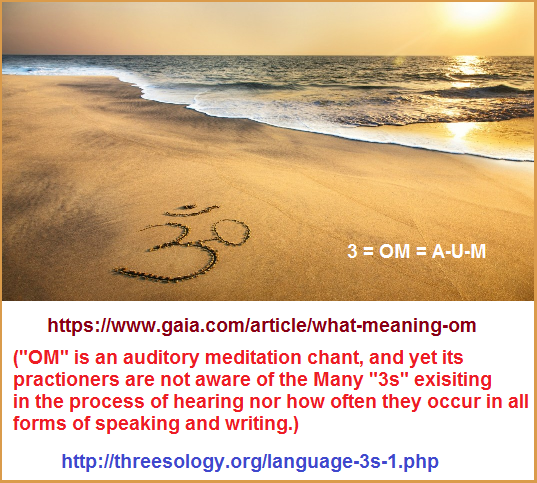
A two-patterned orientation consciously aware of the multiplicity of two-patterns occurring in multiple subjects, intuitively grasps the presence of what appears to be an environmentally influenced, biologically-based, developmental scheme to progress along a one-two-three pattern (that may not always exhibit sequentiality that is smooth and unaltered). By having become conscious of this (whether articulated or not), they aspire to achieve the next stage(s) in their development, typically by way of some repetition; since this model of self-teaching is the method of instruction shown to them in the public education system of rote learning. It is the model they render unto themselves in a similar manner, thinking they will eventually progress to some higher plane of consciousness and/or physical ability, though there aren't any actual textbooks with which to provide them with advanced homework studies... other than those they or another contrives to suit a momentary indulgence or ulterior motive... that often is connected to some commercial scheme for duping people out of some resource, be it money, land, sex, labor, or some other serviceable commodity.
In the presence of a "three-pattern", someone whose mind is exhibiting what may be described as standing at the peak of a two-orientation attempting to reaching beyond themselves, may find a second or central pattern to be most fascinating, or position a third occurrence into a second or central position. Like a three-shells came under which the pea or ball or pebble is placed under the middle or second shell that they visually manipulate hither and thither with their mind... like a self-imposed rock-paper-scissors tick-tack-toe and horizontal-diagonal-vertical chess piece move; they engage in a mental gymnastics in an assumed effort to best the situation and progress beyond it, though they are stuck in the constraint of an overall three guideline, even if it is multiplied many fold like the two-part division of cell multiplicity. The triplet code of their mind asserts itself no matter how often the underlying two-pattern multiplies itself repetitiously, manually, vocally, or otherwise. No less, tripling the triplet code is no escape... is no actual progress beyond what appears to be an environmentally imposed genetically distributed pattern-of-three utilizing an underlying one and two schema of design, just as we see occurring in the on/off binary code of computers attempting to excel its binary code by implementing a usage of a triple-patterned logic code derived from the "four fundamental arithmetic operations addition, subtraction, multiplication, and division which can be reduced to combinations of fundamental Boolean algebraic operations" (Source: "binary code." Encyclopedia Britannica Ultimate Reference Suite), such as the three basic logic functions:
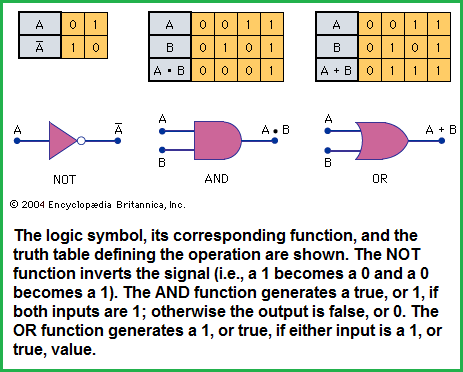
Hence, we have another "2-3-4" pattern to be placed on page 14 of this series. The pattern being the binary, the triple logic, and the four fundamental arithmetic operations (which can be described as a 3-to- ratio).
Let us take a moment's look at a pattern-of-three ensemble where the middle or second delineation is sourced as a preferential intrigue (sometimes labeled as the Intermediate Axis Theorem):
Other variations:
- The Bizarre Behavior of Rotating Bodies, Explained
- The Physics of the Tennis Racket
- Intermediate Axis Theorem
This is a link to a youtube on angular momentum that a colleague sent me which some readers may also be reminded of as having some inter-related connection:
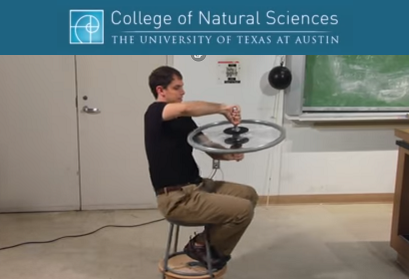
Spinning Wheel on Spinning Chair
However, it must be understood that labeling often portrays an arbitrary exercise of preferencing one first, and those which follow. Take for example the three dimensions of space characteristically illustrate in an X- Y- Z modeling scheme:
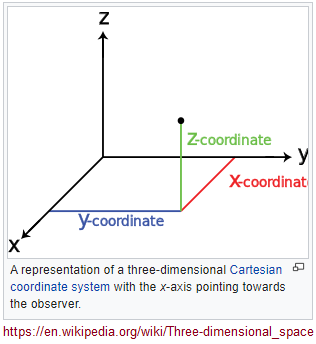
If we then extrapolate the three axis to the idea of a "manifold" (many/ various... or expanded, increased, repeated... etc...) entity, there is applied the definition of a "finite volume and no boundary":
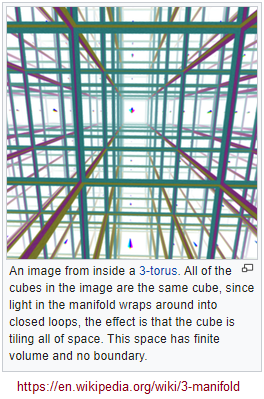
However, if we alter the definition to comply with the reality of what we see in biology, we have to invert the definition to read a suppositional: "Infinite volume and definable boundary", described by the multiplicity of life forms on the one hand and the imposed genetic constraints on the other. The triplet code is an assigned "triple-spaced" boundary which permits what can be perceived to be an exponential ability of growth... so long as some force doesn't act on development— such as an asteroid, ice ball earth, or some other event.
And like the "many-fold" involutions of cubicle expressions within the larger cube (like cell division and multiplication within a single cell), the idea of a three-dimensional space may be little more than an out-growth of the internalized three-oriented direction of development. In other words, while it appears to be a logical perception, the perception is a representative expression of the type of growth pattern humanity is subjected to. It is the reality of the reality to which we are forced to submit to, and is not necessarily the reality of that which may exist outside the domain of our physiologically constrained mental development and equilibrium driven accommodation.
The patterns being recognized within the presumed three-dimensional space we appear to be inhabiting may be little more than a by-product of that which we have to work with in perceiving and illustrating those perceptions. However, the question remains, how do we surpass the limitations, if indeed that is what humanity is experiencing in its present biological form? Can the perceptions beyond human abilities be acquired by supposed electronic and mechanical enhancements like the telescope, microscope and overall increased ranges of perception by way of two-patterned based (on/off switching) electronic media? Or are such electronic and mechanical devices merely extensions of the same limitations we have to work with and can not actually grasp beyond, just as an insect might not be able to make full usage of a human level and type of perception if it were somehow permitted to see through the eyes and mind of a person? Would the world of humans be enhanced or merely substituted if we were enabled to see the world as do other "lower" life forms... though we use the behavior of other life forms to supplement our own with such as silk from silk worms, various plant substances for medications, food, clothing, camouflage tactics, predatory military mechanisms of stealth, etc...
When I look at the foregoing examples of defined spatial currencies, I see body plans... as in the basic body plans we encounter in biology, though I am tempted to include other three-patterned structures as well since they too define articulated intellectual modes of direction like the currents found in the stratifications of solids, liquids and gases... if not plasma as well. Take for example what may be described as the (ocean/sea: water) current driven development of the three body plans of sponges which represent increasing complexity (but they do not imply an evolutionary sequence; according to page 251 of the Integrated Principles of Zoology, 15th edition, ISBN 978-0-07-304050-9), and these morphologies do not define taxonomic groups, according to the information found here: Porifera (sponges)
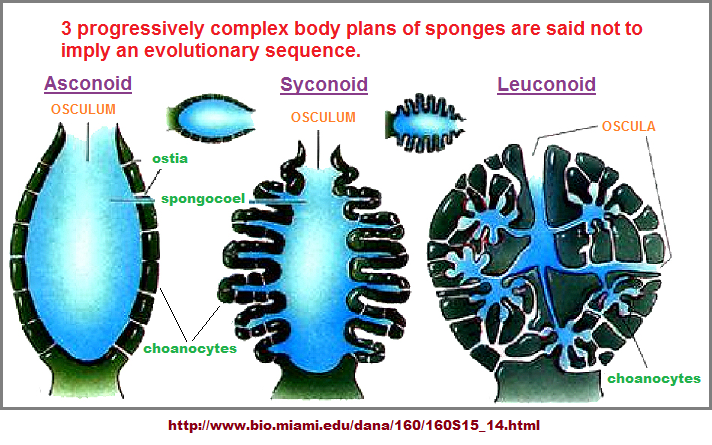
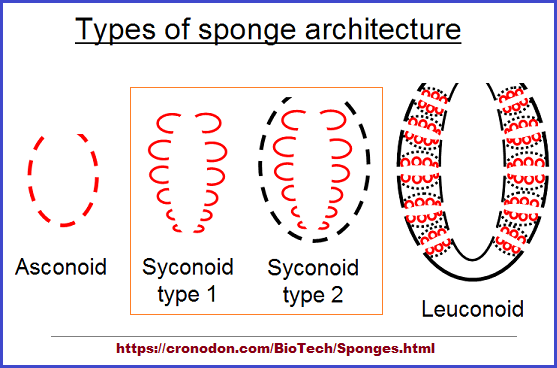
Here's an "architectural" line drawing (so-to-speak) of the three principal internal structures of the sponge, which may aid some readers in distinguishing the increased complexity more easily:
Above: the principle types of sponge internal architecture.
- Asconoid sponges are the simplest and smallest and probably the most ancient in design. The whole inner surface of the asconoid is lined by choanocytes (the choanoderm) as indicated in red.
- The syconoid type represents an array of asconoid types arranged around the cylinder of the sponge (the incurrent pores are not shown, but the red layer is porous in all these sponge types). In type 2 syconoid sponges an additional layer of dermal tissue, perforated by large pores, covers the structure.
- The leuconoid type is the most advanced and consists of an array of syconoid units arranged around a cylinder. Only the layers shown in red, the choanocyte chambers, bear choanocytes, which line the inside only of each chamber.
Syconoid and leuconoid sponges necessarily have a more complex system of pores and channels to convey water through the sponge. The arrangement is such that water only flows through one choanocyte chamber on its passage through the sponge, otherwise energy would be wasted in filtering water that has already been filtered. The more complex syconoid and leuconoid architectures are more efficient and so are able to achieve greater size - an asconoid becomes increasingly less efficient at larger size.
Asconoid sponges are small, and rarely exceed 10 cm in height, but the more complex and efficient leuconoid sponges may reach two metres in height. The architectures shown above are all open architectures, in which water exits through a large central spongocoel cavity. Many sponges have solid architectures, in which a series of channels coalesce to expel water through one or more oscula and the large central spongocoel is essentially absent. Leuconoid sponges are the most common and their architecture may be complicated, such that the sponge's tissue becomes permeated by a complex maze of water channels.
These three body plans, coupled to the body plans mentioned earlier in this series (Asymmetrical, Radial Symmetry, Bilateral Symmetry), and then coupled to the idea of a 3-dimensional symmetry of Astronomy:
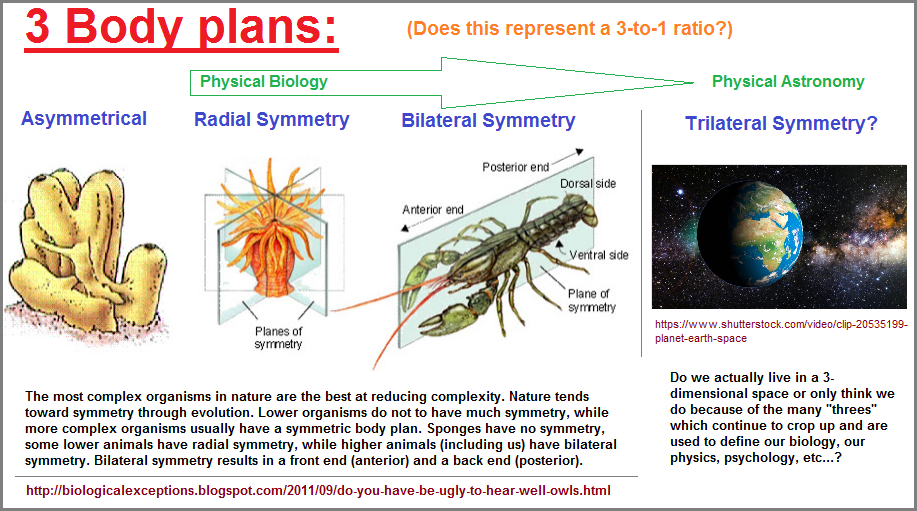
If there is symmetry in the 3-dimensional space as some might want to conclude by an assumed stable planetary system and developmental biology, then does stability require a reversible type of instability as displayed in the above Intermediate Axis Theorem?
Not only do we have this question to reconcile but also the presence of a major "two-patterned" body plan in the recurrence of the mouth and anus points of polarization which may appear to precede and then later on or accompanies the development of a three-patterned body plan beginning with the three germ layers which precede or is accompanied by a four-limb differentiation (not including the head or a tail which gives us a five and a six point figure).
Yet, this 2-3-4/5/6 ensemble of development follows on the trail of the paired amino acids + a triplet code + the primary-secondary-tertiary-quaternary ensemble. Hence, giving us another presumed 4-string... or 3 to 1 ratio string that must be addressed. While it is easy to be selective and talk about a single recurring developmental event or even multiple events during a singular developmental event of a give species, talking about the events as a recurring ensemble for multiple species of animals and multiple species of subjects is another matter.
I can not be in a position to speak on the recurrence of a particular pattern-of-three such as an overt, generalized body plan and attempt to disinclude the presence of a non-three body plan, or appear to be overlooking a larger ensemble of patterns involving different patterns which repeat not only in different life forms, but different forms of thought encompassing multiple subjects in terms of human cognition giving an unrecognized representation of itself as being part of the developmental process of biology attached to the underlying ensemble(s) of patterns.
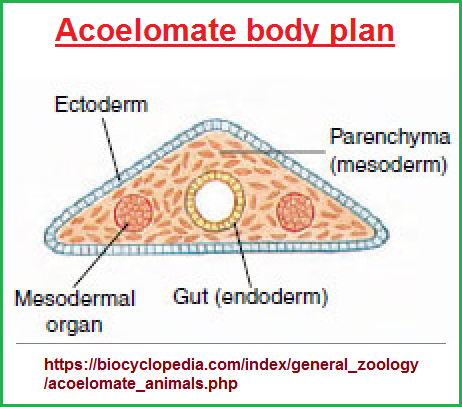
|
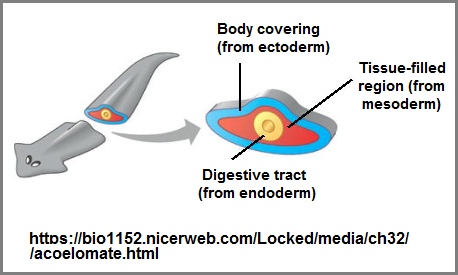
|
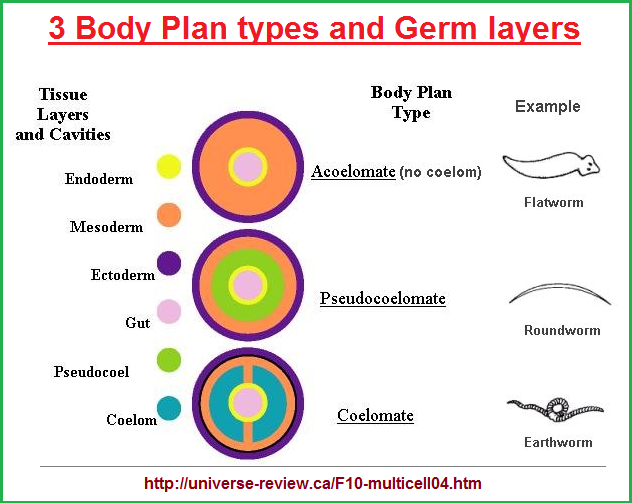 |
|
Let us look at the 3 body plans from a different perspective and compare it to two other three-patterned occasions of development pointing out a recognizable similarity it shape, and also include a comment that the 3-patterned shape ensemble is also sometimes seen in the form of a linear-circular-triangular configuration in other subjects:
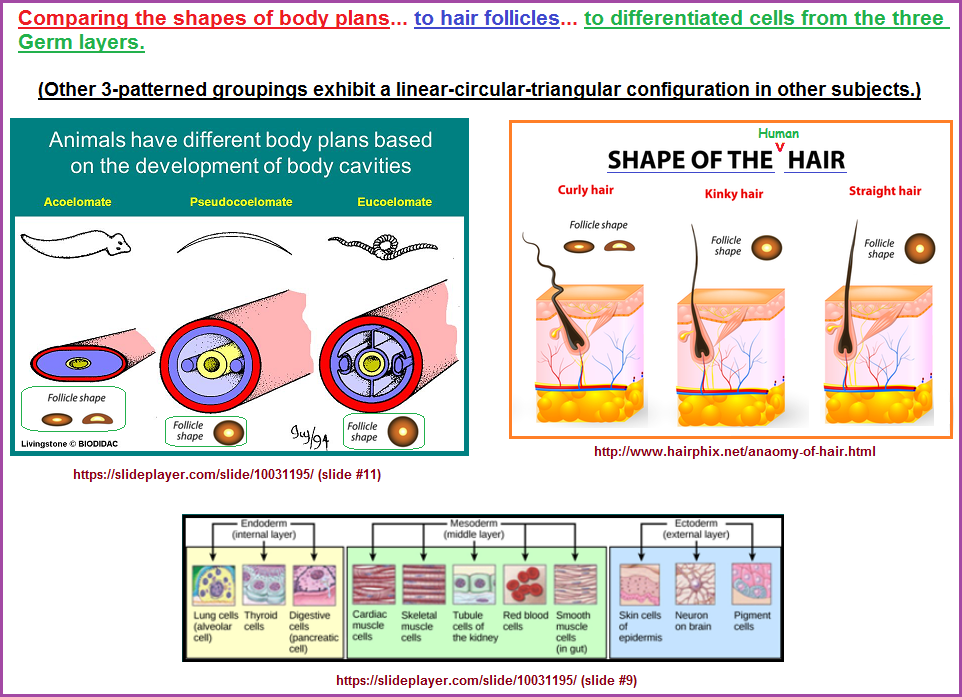 | |
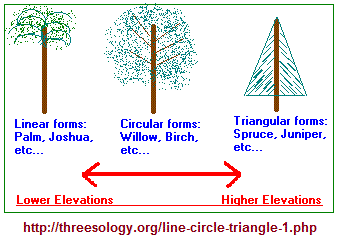 |
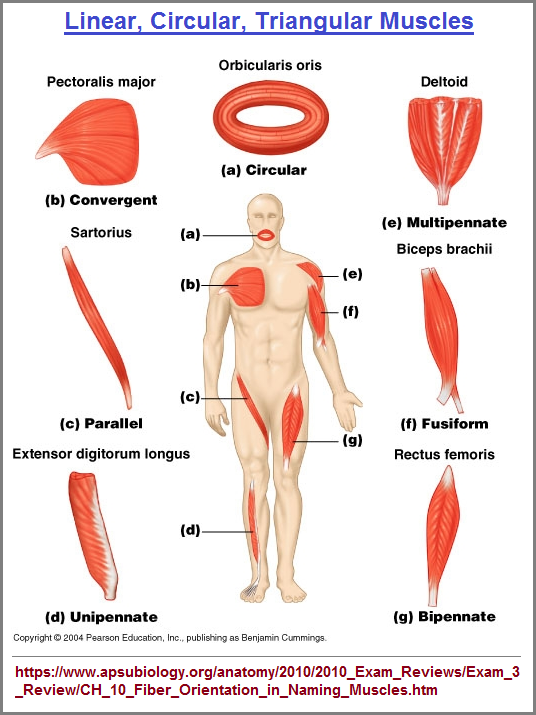 |
In looking at the above schematic of the Acoelomate model, the illustration does not give a decidable impression for the presence of a triangle. However, another person looking at the structure and providing an image may provide a more distinct representation. This difference needs to be taken into account because what one research sees and portrays is not what another one does, even if that being perceived is portrayed in a textbook and taught to thousands of students. Not all researchers see, nor portray in the same way. Some have better vision while some have better artistic skills, writing skills, thinking skills, etc., even if they are provided with an "expert" title or the recognized authority in a given field. Simply repeating what an expert says may give you points with them, but it doesn't mean you or they are correct simply because you are in agreement. Many experts and their followers have been found to be incorrect in their views later on.
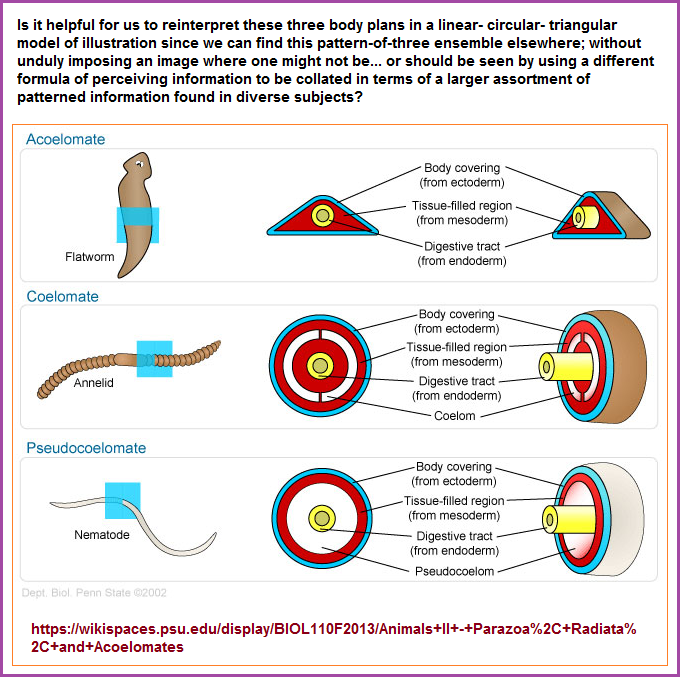
Whereas a room full of experts may indeed perceive a circular conformation and you see something else, this does not make either of you right or wrong, even if a consensus is reached. A difference of opinion and a difference of perception is a representative difference in cognition that illustrates a pattern that needs to be addressed, but this perspective is not a conventional consideration being explored by typically cognitive scientists. Their guesswork is otherwise directed.
The Bilateral body plan presents us with the recurrence of a pattern-of-two in the form of openings called the mouth and anus. While we may want to accept this as the conclusion, as a Threesologist, I look for a third... and more possibilities such as the openings of the ears, nose, eyes (and light sensitive pineal gland), as well as the penis, vagina and overall pores of the body, not to disinclude the belly button where the umbilical cord of nourishment was attached. Hence, there are other orifices, not all of which are located at one or the other end of the body. Nonetheless, when describing the "two", we should not overlook the "many" supplementation's encountered as we venture up the path of organism complexity.
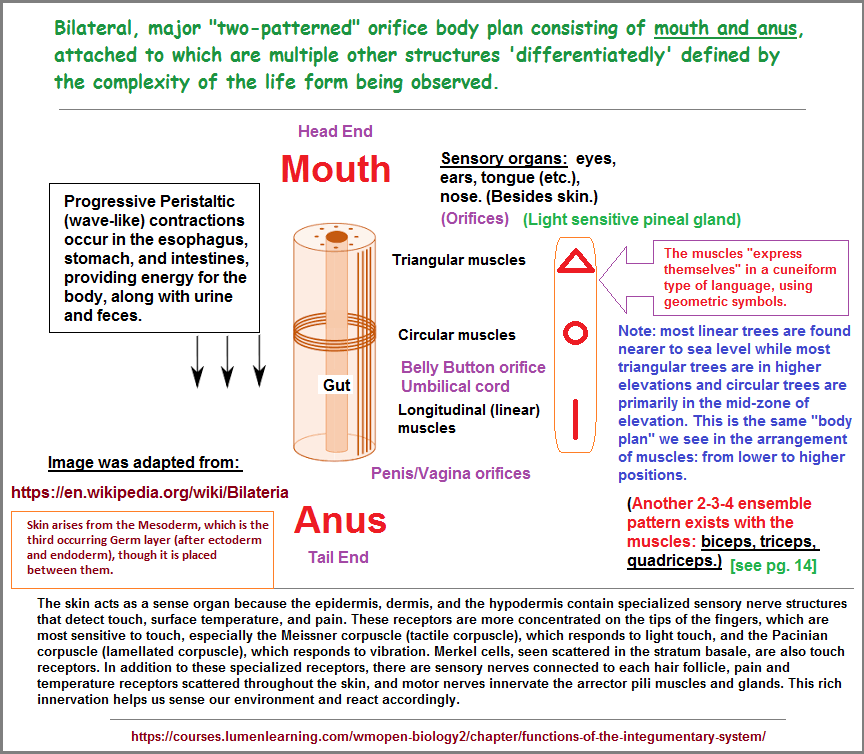
Those researchers who have a two-patterned preferential frame of orientation will necessarily focus on one or another pattern-of-two, either unknowingly, knowingly... and perhaps intentionally, to the point of deliberately down-playing the presence of any other pattern so as not to "discolor" a life-long study of research where one or more particular two (or other) patterns where used as a guide post of research and perhaps teaching rule-of-thumb, just as the "persistent dichotomies" are used in many a psychology class as an expression of psychology's refusal to let go of its antiquated designs.
- The persistence of dichotomies in the study of behavioral development by Timothy D. Johnston
- Persistent Dichotomies a reconstituted list of Dr. Warren's 461 Psychology class
As in the sponges, we see intake and excretion holes with more complex life forms, sometimes referred to as mouth and anus. Hence, this presents us with a pattern-of-two, unless we include the no-hole in our formula of observation. Hence, in this circumstance we have life forms with no-hole, one-hole and two-holes, or we have another pattern-of-three ensemble noted as one-hole, two-holes, many holes. Hence, a "mono- bi/di- poly" ensemble. However, we are faced with a barrage of investigators who not only forget the Universe is young, but also that biology is in its infancy, except that the juvenile and adult stages of development may either be truncated (not fully achieved) or never achieved because the conditions under-which the biology is taking place is on an incremental course of deterioration for which biology must adapt to and create various themes of equilibrium ("rationalization") in physical/emotional and mental (encephalization) terms.
In trying to establish a full-fledged developmental scenario of biology from the inception thought to have occurred on Earth (with or without help from outside the Earth's or Solar system's boundaries), some 3 to 4... more or less billions of years ago, varying methods and models of comparison are created in an honest effort to establish relationships or provide proof of a lack thereof in order to establish a "stand-alone" approximation of developmental occurrence.
Ideas suggesting sequentiality, digression, branching, punctuated emergence, stop-and-go, detour, double-lit candle episodes, flash-in-the-pan, recapitulation (repetition), metamorphic scenarios, rooted scramblings, splash, splat, and spill convergences, etc..., have all been entertained. While this and that with or without variation and adaptation are accepted for long or short durations of investigation, we are doing so with whatever limits of information and techniques of investigation are available to us in a given era within the social and environmental spheres of influence that can be helpful or interruptive. But with respect to the consideration of the present topic about the "hole" presence in developmental biology used in describing the simple to complex forms of life as a means of defining an attribute thereof, our models for examination can become so elaborate that we fail to take a step back and apply a simpler model that has reoccurred several times in different subjects. This being the three-patterned ensemble of One-Two-Many. And yes, a variation of it is expressed in the E Pluribus Unum motto used by the United States, which can be interpreted, in one sense, as expressing the notion of "Out of Many, one". Indeed, out of a Many-holed situation comes the development of a greater complexity that appears to back-track into a simplification, if we can view the two or one-pattern as simplifications and not primivities. Yet, if the "three" pattern is so important, why then does the "one-two-many" not revert to some establish definitive three-pattern, unless because of the incrementally deteriorating environment the "one-two-many" is the adaptive strategy (rationalization) which best fits the conditions?
In the following chart, we see a valid attempt to point out similarities amongst different organisms only to come away with the view that there does not appear to be any definitively expressive correlated centrality of occurrence, unless we invoke the notion that nature does in fact use a variable three-patterned "one-two-three" ensemble as code, that needs to be identified just as we have identified the triplet code in DNA; playing itself out via human cognition.

Gut architecture and hindgut types across animal lineages. Diversity of gut morphologies and types of hindguts observed in the different metazoan lineages, in relation to the most recent animal phylogeny (Dunn et al., 2014). The diagram is a simplification, and exceptions from the general coding are possible.
Though we make charts of our observations, the observations of our chart making behaviors are poorly described by a present day formula of psychology that is obsessed with an inclination to rely on the presence of "persistent dichotomies", because it refuses to mature in its philosophical bases. The few three-patterned ideas which are voiced from time to time: (id-ego-superego, child-parent-adult, oral-anal-genital, child-mother-father, etc...), only hint of an attempted maturity-in-the making, but it pursues the analysis of all or most people from a two-patterned perspective, though there are no doubt those who are described as being ill that are merely those who are trying to cope in a two-patterned social situation with their three-patterned mental orientation which brings them into conflict... and a two-patterned psychology only adds to their conflicts of personalized development.
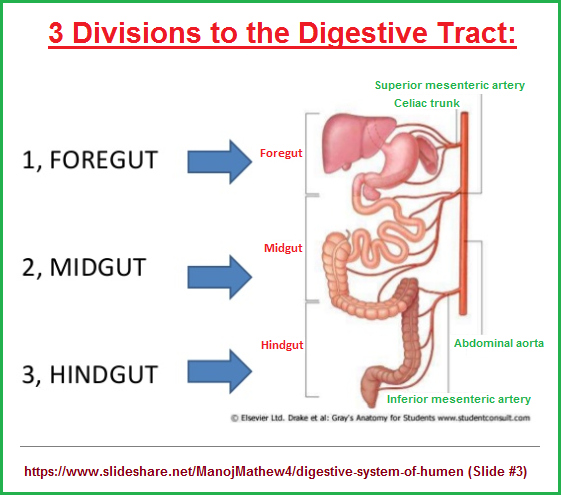
We need to chart human cognition as it charts its own observations of other occurrences in order to illustrate the architecture being used to identify and illustrate our perceptions, whether those perceptions are called studies, considerations, research, investigation, entertainment, analysis, viewing, etc., in terms of promoting an intended seriousness or casualness of applied observation. (Whether observations are being denoted as serious such as in research efforts, or common-place such as in being a mere spectator.) Charting the patterns of human cognition being employed by a given person or group of people involved in an "observation" (labeled detailed or "doodling", will help us determine whether they are using a repetition of thought processing that has bogged them down, or if they indulge in a larger breadth, depth, length and duration of consideration. Are the patterns that are being used due to the material, or because they are being imposed on the material to make the information fit a particular model because a given researcher has a sentimental proclivity for a given pattern-of-mind/thinking?
In thinking about the patterns to be identified in patterns... or the patterns in patterns in patterns... etc., those which reoccur like patterns-of-three, patterns-of-two, etc, and the absence there of being replaced (repeatedly?) by one or another patterns as an identifiable sequentiality; so too must we consider other models of three-patterned codes such as the 2-3-4, 3-to-1, 3 or 1, the second but not 1st or 3rd, etc..., in order to create a model of interpretation and illustration that may well describe the course of nature as we are able to observe it under the present constraints and deteriorations.
There may be "many" different variations of patterns-of-three, including those that are absent one or two of the three variables that may not be expressed with a number, letter, or other graphic symbol, but some other qualitative or quantitative measure applicable to a given means of perception (sound, sight, taste, touch, gravitational, etc..). The pattern need not be expressed as a 1-2-3, or a-b-c, or x-y-z, or 2-3-4, or 1-2-many, or with a word, dot-dash-dot, stop-caution-go, etc... All of which are expressed exhibitions which biological processes appear to carry out, though those doing the investigation either restrict themselves, or are restricted by the conventions of the type(s) of language and illustration models being used in their respective field. If an investigator who uses a given pattern for all their research claims this is because the material they are researching exhibits this pattern, does it actually do so, or is the investigator merely well-versed in convincing others to see the same thing (like a dominant person framing a situation to fit their inclinations that subordinates feel obligated to follow)? If the information does reflect a recurring pattern, is this due to the time and place the information is situated in, or because the information is so selective it can not but express a constraint that one or more researchers capitalize on and "own" as a viable research commodity so as to use it as a means of personal survival interests in a given research field that uses the information as a pseudo-planetary system around which others are socially forced to revolve?
Nature may in fact use one, two, and three-patterned ensembles with as much variety as we are claiming exists in the broader-based biology of the planet. Nature may have its own counting scheme of which our own three-patterned groupings reflectively describe, such as in the example seen in mathematics where ones-tens-hundreds are followed by a comma is a mere reflection of a larger biological usage thereof... like a child mimicking a behavior of its parental influence... in this case such that the parent is the nature of our developmental nature which, like circadian and other rhythms, repeats itself with colors and flavors and variation just as we note in particle physics; but there is an underlying pattern-of-three which may be a perception due to environmental influence which gives the impression of stability but has a half-life we have not measured as yet.
Origination date: Friday, October 4th, 2019... 2:32 AM
Initial Posting: Sunday, October 6th, 2019... 10:23 AM
Updated Posting: Tuesday, October 22nd, 2024... 9:39 AM
Herb O. Buckland
herbobuckland@hotmail.com